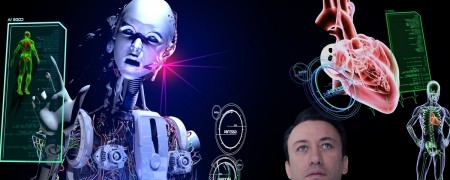AI ENABLED HEART SURGERY, REALLY?


Sat 06 October 2018
From autonomous cars to clinical diagnosis, artificial intelligence (AI) is already carving an unstoppable path into the way we will live our lives.
Most doctors will now accept that computer algorithms will ultimately outperform even the most well read and experienced doctor in the area of medical diagnosis and disease recognition. In radiology, for example, AI is being used to interpret x-ray images with greater speed and accuracy than trained doctors. In pulmonary medicine one of the best diagnostic modalities is already a computer program. Google’s deep learning algorithm can diagnose diabetic retinopathy more reliably than internationally recognised eye specialists.
But what about surgery?
And more specifically, what about highly complex heart surgery?
As a heart surgeon with a specialist interest in robotic surgery, I am often asked if AI enabled robots could ever perform cardiac procedures. Most heart surgeons will immediately suggest that this is an impossibility. An appreciation of where AI is today, and where it may be tomorrow, leads me to think otherwise. Let me explain why.
In order for AI enabled robotic surgery to become a reality we will need to build robots with the surgical dexterity to perform complex tasks and provide them with the necessary algorithms required for complex decision making and deep learning. A renewed training model for doctors of the future needs to be considered by trainers in which an understanding of digital capabilities is better appreciated. In all of this, the patient must remain at the centre of development in order to encourage an atmosphere of trust an engagement.
So can robots possess surgical dexterity?
I have witnessed, first-hand the power of robotic technology in the performance of complex keyhole cardiac procedures. Surgeons can use robots to bypass blockages in heart arteries, replace heart valves, and even perform highly intricate heart valve repair. The minimal trauma associated with these techniques means that patients heal in days rather than months (when performed by experienced teams) which represents a real value proposition for patients and healthcare providers.
Of course, one needs to recognise that during these procedures the robot is not thinking for itself, rather it is allowing a trained surgeon to use superior 3D imaging, surgical site magnification, and movement stabilisation to perform a procedure on a TV monitor with greater accuracy than would otherwise be possible. So, whilst these robots may not be making decisions yet, they possess the dexterity to perform highly complex procedures albeit under the direction of the surgeon.
Can AI algorithms really be developed?
In order to explore this problem, we need to recognise the changes which are already taking place in the surgical treatment of heart disease.
Everyone knows a friend or relative who has had a stent placed inside a blocked heart artery to treat angina or to rapidly reverse an evolving heart attack. In recent years these skills have been extrapolated to the treatment of diseased heart valves. Transfemoral aortic valve implantation involves the delivery of a collapsed man-made valve through a specialised catheter placed into the body via an artery in the groin. The collapsed valve is carefully placed inside the diseased heart valve where, upon deployment, works immediately to replace the dysfunctional native heart valve. Over the next 20 to 30 years, it is likely that the majority of surgical procedures on the heart will be performed using transcatheter techniques like this. Since much of the decision making used by surgeons using these techniques are based upon highly accurate image acquisition technologies, it is not difficult to see how carefully developed algorithms could eventually be used to make these important decisions instead of a human operator. Add to this a robotic delivery technique and you have an exquisitely precise AI equipped transcatheter robotic device with deep learning capabilities which could become far superior to a human.
How do we train surgeons of the future?
AI is an inevitability and unless the correct stakeholders are at the table, we will find that we are only predicting, rather than proactively building the future. AI, like virtual reality and augmented reality are real players in the future training of healthcare professionals yet many young doctors do not truly understand what they represent never mind any appreciation of their applicability in healthcare.
In order to truly shape the direction of AI in the treatment (and prevention) of heart disease, we must equip future specialists with a deep understanding of human function in health and disease, as well as an even deeper understanding of what the digital age is capable of achieving. Those clinicians who are able to understand and cross fertilise these important disciplines will be the ones who will carve their own unique niche.
Why is patient involvement essential?
The idea that your heart surgery is about to be performed by an AI enabled robot is likely to make even the most insightful and open-minded patient somewhat apprehensive. Public and patient engagement in technological developments will be essential to ensure that industry instils trust in AI enabled robotic technologies. The consequences of even a single fatal error made by an AI enabled robot will be seen as unacceptable. These concerns will make it likely that clinically supervised AI enabled robotic procedures will remain an essential pre-requisite for many years following introduction of these new technologies.
What ethical issues will need to be considered?
AI enabled robotic surgery raises a number of ethical and medicolegal dilemmas:
In the event of clinical error, who, or what, is responsible?
Can a patient sue a robot for malpractice, or does the responsibility fall directly with the surgeon?
Will the manufacturer carry the responsibility for unacceptable complications arising from surgery?
Negligence itself implies a situation where AI inherently lacks an awareness for preventing an avoidable morbidity or mortality. Using this argument, it becomes clear that at least some culpability falls with the algorithm designers.
On a more optimistic note, a well-designed self-learning algorithm should ensure that any error can happen only once. Mistakes made by humans are rarely isolated events as we are far more prone to make the same errors more than once.
Concluding remarks:
In this article we have explored the possibilities of AI enabled robotic surgery. Over the next 20 to 30 years there are likely to be a number of other equally disruptive technologies which will change the landscape of disease prevention and treatment. Genomic analysis will play an enormous role in identifying an individual’s risk factors for disease development in the hope that lifestyle modification, early disease recognition, and even gene manipulation can be used to alter adverse outcome. Advances in 3D bioprinting will allow doctors to produce genetically identical organs which can be used for transplantation thus removing the risks associated with organ rejection and scarcity.
It is inevitable that we will look back on today’s world and wonder how we survived during such primitive times.
Inder Birdi 2018.
If you would like to find out more, get in contact with one of our experts at our London Heart Clinic or Essex Heart Clinic.

